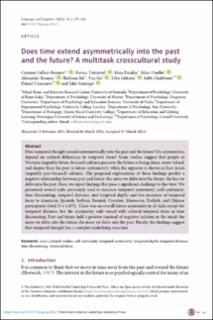Does time extend asymmetrically into the past and the future? A multitask crosscultural study
| dc.contributor.author | Callizo-Romero, Carmen | |
| dc.contributor.author | Tutnjević, Slavica | |
| dc.contributor.author | Pandza, Maja | |
| dc.contributor.author | Ouellet, Marc | |
| dc.contributor.author | Kranjec, Alexander | |
| dc.contributor.author | Ilić, Sladjana | |
| dc.contributor.author | Gu, Yan | |
| dc.contributor.author | Göksun, Tilbe | |
| dc.contributor.author | Chahboun, Sobn | |
| dc.contributor.author | Casasanto, Daniel | |
| dc.contributor.author | Santiago, Julio | |
| dc.date.accessioned | 2022-09-27T09:23:42Z | |
| dc.date.available | 2022-09-27T09:23:42Z | |
| dc.date.created | 2022-04-30T13:33:27Z | |
| dc.date.issued | 2022 | |
| dc.identifier.citation | Language and Cognition. 2022, 14 (2), 1-28. | en_US |
| dc.identifier.issn | 1866-9808 | |
| dc.identifier.uri | https://hdl.handle.net/11250/3021684 | |
| dc.description.abstract | Does temporal thought extend asymmetrically into the past and the future? Do asymmetries depend on cultural differences in temporal focus? Some studies suggest that people in Western (arguably future-focused) cultures perceive the future as being closer, more valued, and deeper than the past (a future asymmetry), while the opposite is shown in East Asian (arguably past-focused) cultures. The proposed explanations of these findings predict a negative relationship between past and future: the more we delve into the future, the less we delve into the past. Here, we report findings that pose a significant challenge to this view. We presented several tasks previously used to measure temporal asymmetry (self-continuity, time discounting, temporal distance, and temporal depth) and two measures of temporal focus to American, Spanish, Serbian, Bosniak, Croatian, Moroccan, Turkish, and Chinese participants (total N = 1,075). There was an overall future asymmetry in all tasks except for temporal distance, but the asymmetry only varied with cultural temporal focus in time discounting. Past and future held a positive (instead of negative) relation in the mind: the more we delve into the future, the more we delve into the past. Finally, the findings suggest that temporal thought has a complex underlying structure. | en_US |
| dc.description.abstract | Does time extend asymmetrically into the past and the future? A multitask crosscultural study | en_US |
| dc.language.iso | eng | en_US |
| dc.publisher | Cambridge University Press | en_US |
| dc.rights | Navngivelse 4.0 Internasjonal | * |
| dc.rights.uri | http://creativecommons.org/licenses/by/4.0/deed.no | * |
| dc.title | Does time extend asymmetrically into the past and the future? A multitask crosscultural study | en_US |
| dc.title.alternative | Does time extend asymmetrically into the past and the future? A multitask crosscultural study | en_US |
| dc.type | Peer reviewed | en_US |
| dc.type | Journal article | en_US |
| dc.description.version | publishedVersion | en_US |
| dc.source.pagenumber | 1-28 | en_US |
| dc.source.volume | 14 | en_US |
| dc.source.journal | Language and Cognition | en_US |
| dc.source.issue | 2 | en_US |
| dc.identifier.doi | 10.1017/langcog.2022.5 | |
| dc.identifier.cristin | 2020313 | |
| cristin.ispublished | true | |
| cristin.fulltext | original | |
| cristin.qualitycode | 1 |

